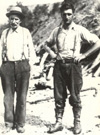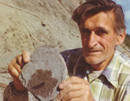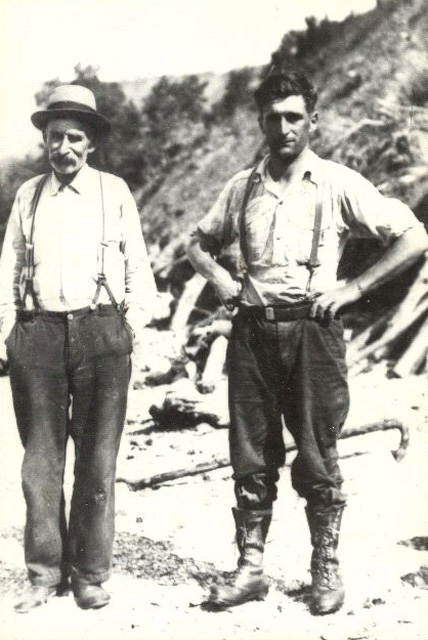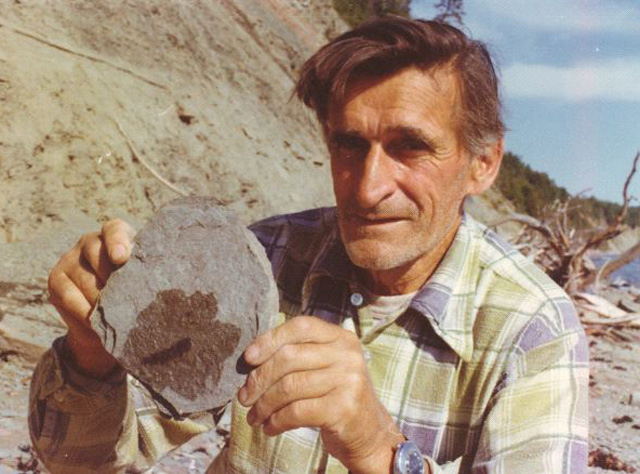Local fossil hunters
Throughout most of the 20th century, scientists and fossil collectors visiting Miguasha maintained close contact with local fossil digging experts. The human history of this famous site would not be complete without the stories of these men who familiarized themselves with the cliffs and shared their knowledge with outsiders. They were known for their keen ability to steer expedition teams towards the “fishier” sites, and would even take part in the fossil digs.
Field work at the cliff was often a family affair, and a “hunting instinct” seems to have been passed from father to son. The Landry, Parent and Roy families were all actively involved, but the most notable was the Plourde family. For three generations, the Plourdes lent a helping hand to visitors and maintained regular correspondence with many of them.
The patriarch of the family was Antoine Plourde, born in Miguasha in 1860. He assisted representatives from the American Natural History Museum in New York, the Museum of Comparative Zoology at Harvard University in Massachusetts, and the Swedish Natural History Museum History in Stockholm. In 1913, Mr. Plourde also received members of the 12th International Geological Congress, which was hosted in Canada that year by the Canadian Geological Survey. For the occasion, he displayed his most beautiful specimens on the beach at Miguasha. But, once the crowd had dispersed, Mr. Plourde found himself in front of empty tables...

 (52 kb)In his 1923 book L’Île Percée, John Mason Clark, the director of the New York State Museum, wrote, “The fruits of Anthony’s handiwork lie in the museums of the world and in his honest, earnest fashion he has done much to give the world a truer knowledge of these strange creatures of a longago day.” He added that Mr. Plourde “...helped to rifle the rocks of their fishes ever since the place was discovered by the geologists of forty years ago...”.
(52 kb)In his 1923 book L’Île Percée, John Mason Clark, the director of the New York State Museum, wrote, “The fruits of Anthony’s handiwork lie in the museums of the world and in his honest, earnest fashion he has done much to give the world a truer knowledge of these strange creatures of a longago day.” He added that Mr. Plourde “...helped to rifle the rocks of their fishes ever since the place was discovered by the geologists of forty years ago...”.
Antoine’s son Euclide shared his father’s passion, and assisted the same researchers and many new visitors as well, including groups from the Royal Ontario Museum in Toronto. Euclide Plourde guided and worked with René Bureau in the cliff, as well as with the first permanent teams to be stationed at the site in the mid-1970’s. He remained active until his death in 1979.

 (56 kb)More recently, Euclid’s son Ralph has also been involved with researchers. And in 1951, to honour the Plourde family, Swedish paleontologist Tor Ørvig named a Miguasha placoderm Plourdosteus.
(56 kb)More recently, Euclid’s son Ralph has also been involved with researchers. And in 1951, to honour the Plourde family, Swedish paleontologist Tor Ørvig named a Miguasha placoderm Plourdosteus.
Field work at the cliff was often a family affair, and a “hunting instinct” seems to have been passed from father to son. The Landry, Parent and Roy families were all actively involved, but the most notable was the Plourde family. For three generations, the Plourdes lent a helping hand to visitors and maintained regular correspondence with many of them.
The patriarch of the family was Antoine Plourde, born in Miguasha in 1860. He assisted representatives from the American Natural History Museum in New York, the Museum of Comparative Zoology at Harvard University in Massachusetts, and the Swedish Natural History Museum History in Stockholm. In 1913, Mr. Plourde also received members of the 12th International Geological Congress, which was hosted in Canada that year by the Canadian Geological Survey. For the occasion, he displayed his most beautiful specimens on the beach at Miguasha. But, once the crowd had dispersed, Mr. Plourde found himself in front of empty tables...

 (52 kb)In his 1923 book L’Île Percée, John Mason Clark, the director of the New York State Museum, wrote, “The fruits of Anthony’s handiwork lie in the museums of the world and in his honest, earnest fashion he has done much to give the world a truer knowledge of these strange creatures of a longago day.” He added that Mr. Plourde “...helped to rifle the rocks of their fishes ever since the place was discovered by the geologists of forty years ago...”.
(52 kb)In his 1923 book L’Île Percée, John Mason Clark, the director of the New York State Museum, wrote, “The fruits of Anthony’s handiwork lie in the museums of the world and in his honest, earnest fashion he has done much to give the world a truer knowledge of these strange creatures of a longago day.” He added that Mr. Plourde “...helped to rifle the rocks of their fishes ever since the place was discovered by the geologists of forty years ago...”.Antoine’s son Euclide shared his father’s passion, and assisted the same researchers and many new visitors as well, including groups from the Royal Ontario Museum in Toronto. Euclide Plourde guided and worked with René Bureau in the cliff, as well as with the first permanent teams to be stationed at the site in the mid-1970’s. He remained active until his death in 1979.

 (56 kb)More recently, Euclid’s son Ralph has also been involved with researchers. And in 1951, to honour the Plourde family, Swedish paleontologist Tor Ørvig named a Miguasha placoderm Plourdosteus.
(56 kb)More recently, Euclid’s son Ralph has also been involved with researchers. And in 1951, to honour the Plourde family, Swedish paleontologist Tor Ørvig named a Miguasha placoderm Plourdosteus.Site map | Feedback | Links | Sources | Credits
Local fossil hunters
<< Links to Scotland | Erik Jarvik and the Prince of Miguasha >>




